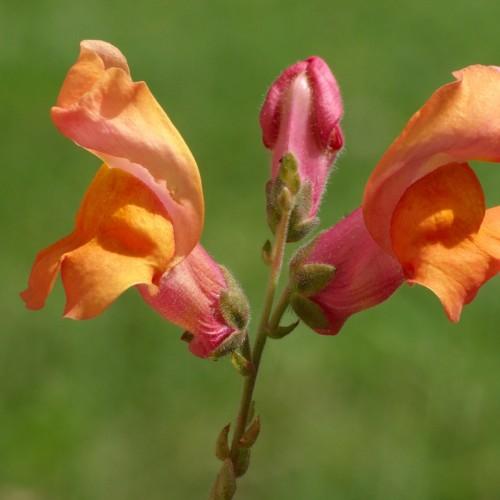
snapdragon
Antirrhinum majus SNAPTASTIC ORANGE FLAME
Cycle:
Herbaceous Perennial
Watering:
Average
Hardiness Zone:
8 - 11
Flowers:
Flowers
Sun:
Full sun
Leaf:
Yes
Growth Rate:
High
Maintenance:
Moderate
Drought Tolerant:
Yes
watering
Water Snapdragons weekly, allowing the soil to dry out slightly between waterings. On average, you should water your Snapdragons a total of 1-2 inches per week. This can be achieved by about 10 minutes of irrigation every other day, or up to 20 minutes of irrigation 2 to 3 times a week. Keep an eye and feel the moisture of the soil. If the soil feels dry up to your second knuckle, it is time to water. Avoid over or under-watering because this can cause problems with nutrients and tissue damage.
sunlight
Snapdragon (Antirrhinum majus SNPTASTIC ORANGE FLAME) thrives best with full sunlight at least 6 to 8 hours a day. This plant prefers direct sunlight for most of its growth period to ensure beautiful blooms. If you live in a hot, sunny climate, this snapdragon may tolerate slightly less sun, but will still need to receive at least 4 to 6 hours of sunlight daily. If growing the plant indoors, it will need to be placed in a bright south or east facing window and may need to be supplemented with artificial lighting for additional hours of light. In colder climates, where the sun may not be as intense, the snapdragon will still benefit from an hour or 2 of direct sunlight a day and also from bright, indirect light for a few hours each day.
pruning
For the Snapdragon (Antirrhinum majus Snaptastic Orange Flame) species pruning should be done 2 times per year. In the spring, as soon as you see new growth, pinch off the top 3 inches of each stem with your thumb and index finger. This encourages a bushy shape and encourages lots of flower production. In late midsummer after flowering has begun to decline, cut the stems back to 6 inches. This will encourage branching and lead to an even better showing of flowers in the late summer and fall.
Propagation
Season
Hardiness Map
FAQ
Is it easy to grow dog flower plants?
No, growing dog flower plants is not easy. These plants require a specific soil and climate conditions to thrive, such as full sun and well-drained soil. Dog flowers need ample amounts of water, but grown in overly wet conditions, the roots may rot, resulting in an unhealthy plant. Additionally, these plants must be pruned and fertilized regularly in order to encourage healthy new growth and to maintain the desired shape. Lastly, dog flowers are susceptible to a variety of diseases and pests, so careful monitoring of plants is necessary.
Do dog flowers bloom all year round?
No, dog flowers do not bloom all year round. Dog flowers are a type of plant that is perennial, meaning they grow and bloom in the spring and summer months and then go dormant in the fall and winter. Depending on what species of dog flower you have, blooms may appear again in early spring, or the plant may take several years before it blossoms again.
Are dog flowers easy to propagate?
No, dog flowers, also known as African violets, are not easy to propagate. African violets are hard to propagate from cuttings as the leaves can be damaged, and their small root systems can be difficult to work with. Additionally, these flowers are unlikely to produce blooms if propagated from leaf cuttings. However, African violets can be propagated from seed, although it can be quite challenging, especially for the novice gardener.
Should dog flowers be grown from seeds or cuttings?
Whether or not you should grow dog flowers from seeds of cuttings depends on the variety of dog flower you wish to grow. Some dog flowers do not come true from seed, meaning that the flowers that grow from the seeds will not necessarily be the same as the flower the seed was taken from. If the exact same flower is desired, then cuttings should be used to propagate the plant. However, if you are looking for an interesting mix of colors and varieties, then growing dog flowers from seed may be the way to go.
Is the dog flower plant endangered?
No, the dog flower plant is not endangered. The plant is native to southern New Caledonia, where it can be found in open grasslands, but it is not considered threatened or vulnerable in any way. The plant is very common in the area and the current population trend is stable. As with any species, human activity around the planet can be a threat to the long-term survival of the dog flower plant, which is why conservation initiatives for the area are important.
Is the dog flower plant drought-tolerant?
No, the dog flower plant is not drought-tolerant. Instead, it needs regular watering and full sunlight to thrive and flower. It grows best in well-drained soil, and should have fertilizer applied twice a year. Plus, it is not particularly heat-tolerant and prefers cooler temperatures.
